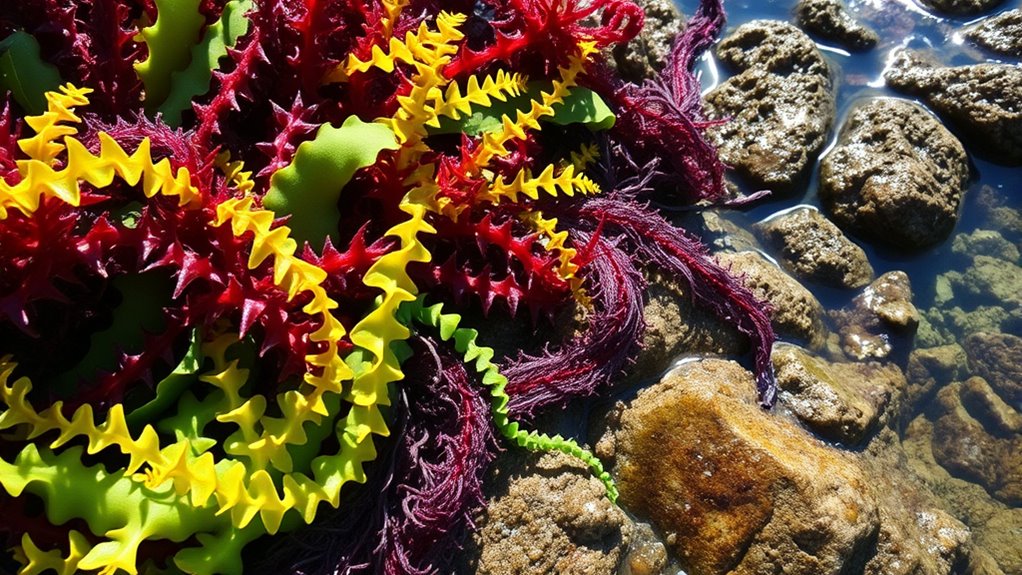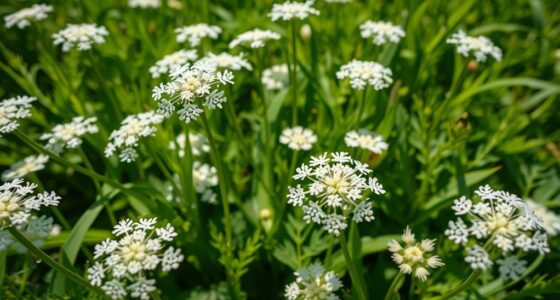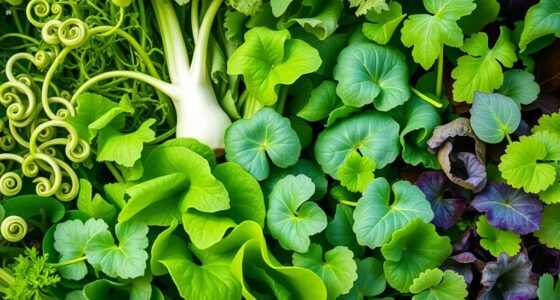On the coast, you can harvest several edible seaweeds like kelp, nori, and sea lettuce, which thrive in nutrient-rich waters. Kelp is rich in iodine and ideal for soups and salads, while nori can be sliced into sheets for sushi or snacks. Sea lettuce is versatile and easy to prepare fresh or dried. Learning sustainable harvesting methods helps protect these resources and supports local ecosystems—discover more about these tasty ocean gems below.
Key Takeaways
- Common edible seaweeds include nori, kelp, sea lettuce, Irish moss, and hijiki.
- Harvest these seaweeds responsibly using tools like scissors or hand-picking to ensure sustainability.
- Proper preparation involves rinsing, soaking, blanching, or drying to maintain quality and safety.
- Edible seaweeds are rich in nutrients like iodine, vitamins, minerals, and antioxidants.
- Coastal regions with rocky shores and nutrient-rich waters are ideal for harvesting these seaweeds sustainably.
Nori (Porphyra Spp.)
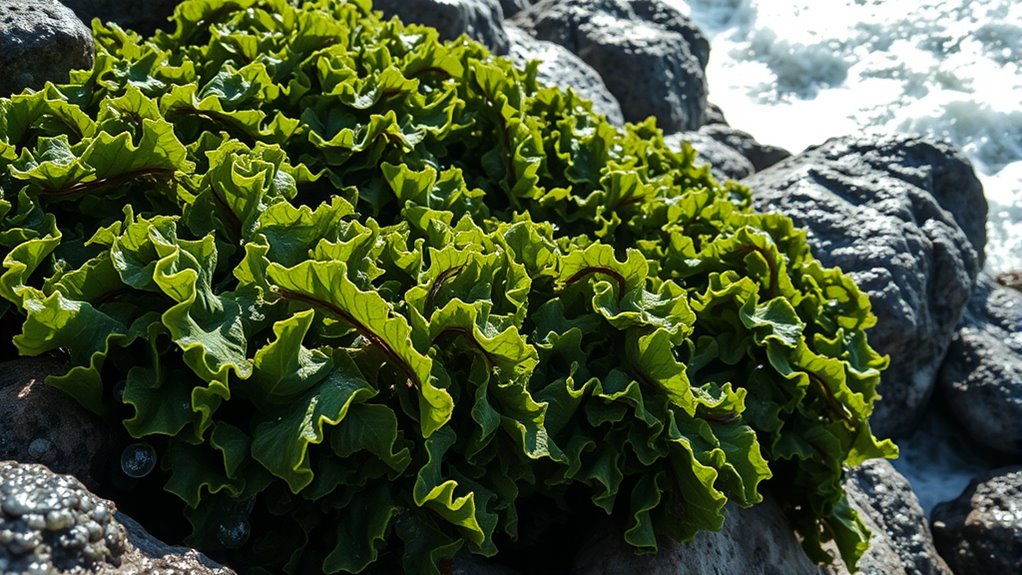
Nori, scientifically known as Porphyra species, is a popular edible seaweed widely used in Japanese cuisine. When harvesting nori, you’ll need specific tools like sickles or scissors to cut the delicate sheets from the sea surface carefully. Proper harvesting tools help prevent damage to the seaweed and ensure a healthy crop for future growth. Once collected, preservation techniques become essential to maintain freshness and flavor. Traditional methods include air drying or stacking the sheets to facilitate natural drying, while modern approaches may involve controlled dehydration or freezing. These preservation techniques help extend shelf life and retain the nutrient content. Additionally, understanding the harvesting process and the ideal environmental conditions can significantly influence the quality of the final product. By using the right tools and techniques, you can enjoy high-quality nori, whether for direct consumption or further processing.
Kelp (Laminaria Spp. and Macrocystis Spp.)
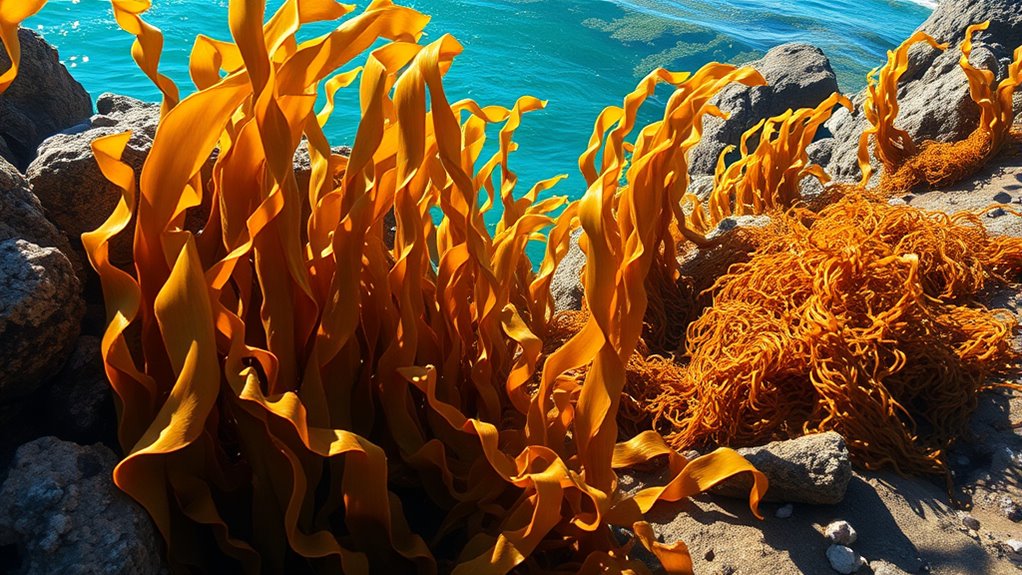
Kelp from Laminaria and Macrocystis species offers versatile culinary and nutritional benefits, but knowing when and where to harvest is vital. You’ll want to pay attention to local seasons and sustainable sources to guarantee quality and safety. Once harvested, proper preparation and usage can maximize its flavor and health benefits.
Harvesting Seasons and Locations
Have you ever wondered when and where to harvest kelp species like Laminaria and Macrocystis? The best time is during the peak of seasonal variations, typically in spring and early summer, when these seaweeds are most abundant and healthy. To guarantee sustainable harvesting, avoid overharvesting in any one area and leave enough kelp to regenerate naturally. Look for kelp beds near rocky coastlines, where currents deliver nutrients and promote growth. Coastal regions with clear waters and strong tidal flows are ideal locations. By harvesting responsibly during the right seasons, you help maintain healthy kelp populations and protect the marine ecosystem. Always check local regulations to ensure compliance and support sustainable practices. Additionally, understanding the growth cycles of seaweeds can help inform better harvesting strategies.
Preparation and Edibility Tips
To enjoy kelp’s nutritional benefits and unique flavor, proper preparation is key. First, rinse the kelp thoroughly to remove sand and salt. Then, follow these steps:
- Soak in freshwater for 10-15 minutes to reduce saltiness.
- Blanch in boiling water for 1-2 minutes to soften and kill bacteria.
- Drain and chop into desired sizes.
- Store in airtight containers in the fridge for up to a week.
- Maintaining sustainable harvesting methods ensures the longevity of edible seaweed varieties and protects marine ecosystems.
Using sustainable harvesting methods guarantees you preserve edible seaweed varieties for future harvests. Always handle kelp carefully to avoid damaging the ecosystem. Proper cleaning and cooking release kelp’s flavor and nutritional value, making it a delicious addition to various dishes. With these tips, you’ll maximize your harvest and enjoy kelp safely and sustainably.
Nutritional and Culinary Uses
Because of its rich nutrient profile, kelp (Laminaria spp. and Macrocystis spp.) plays a valuable role in both culinary and health contexts. Culturally, kelp has deep roots in coastal traditions, serving as a nutritional staple and ingredient in soups, salads, and teas. Its high iodine, vitamins, and minerals boost your health, supporting thyroid function and immunity. Using kelp responsibly helps minimize environmental impact by preventing overharvesting and promoting sustainable practices. Incorporating kelp into your diet not only honors cultural significance but also contributes to environmental preservation. Its versatility in cooking allows you to enjoy its unique umami flavor while benefitting from its nutritional richness. As you embrace kelp, you participate in a tradition that respects both cultural heritage and ecological balance.
Dulse (Palmaria Palmata)
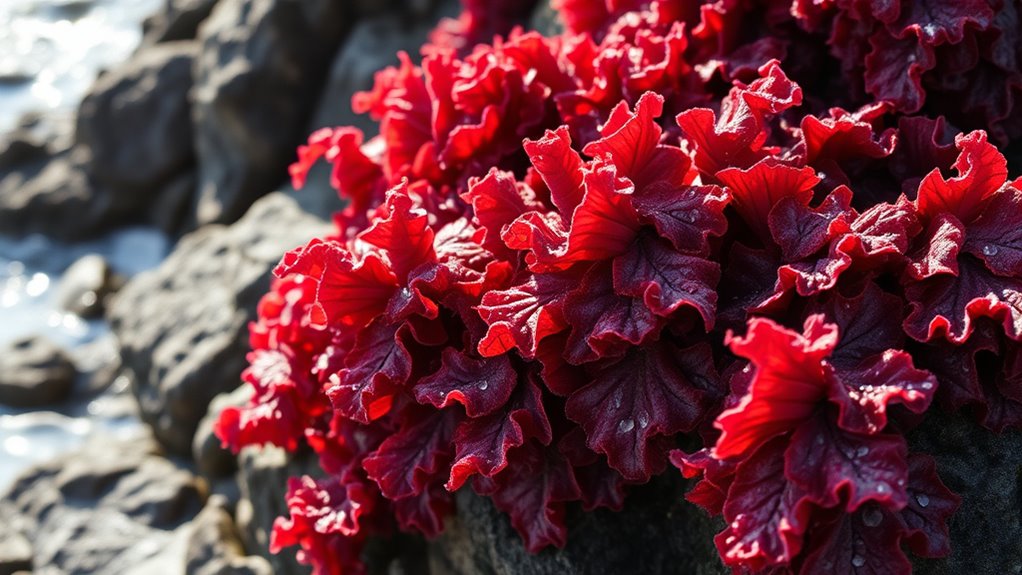
Did you know that dulse (Palmaria palmata) is a flavorful, reddish seaweed packed with nutrients? When harvesting dulse, keep these tips in mind:
- Always prioritize harvesting safety by wearing gloves and observing local regulations.
- Use sustainable practices, such as only taking what you need and avoiding overharvesting.
- Harvest from clean, unpolluted waters to guarantee quality and safety.
- Be gentle when collecting to avoid damaging the surrounding ecosystem.
- Choose a high-pressure water spray to help clean your harvest more effectively before consumption.
Wakame (Undaria Pinnatifida)
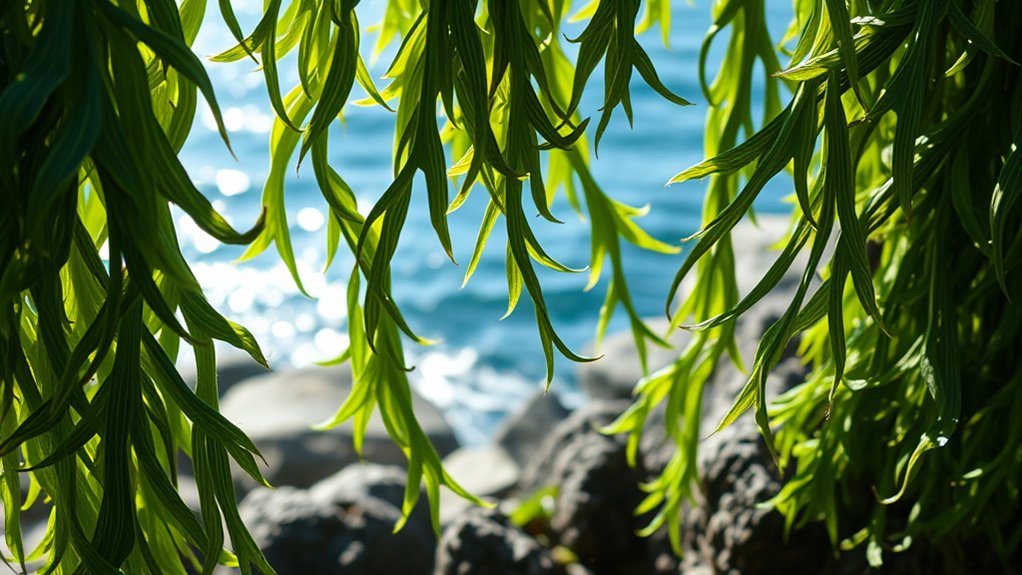
Wakame (Undaria pinnatifida) is a popular edible seaweed known for its delicate texture and mildly sweet flavor. It’s often harvested sustainably to guarantee wild populations remain healthy and abundant. You can also find wakame through seaweed farming, which offers a controlled environment that minimizes ecological impact. This approach helps meet demand without overharvesting natural beds. When harvesting, focus on mature fronds to promote regrowth and maintain the seaweed’s natural balance. Wakame is versatile in the kitchen, adding flavor and nutrients to soups, salads, and other dishes. By supporting sustainable harvesting and seaweed farming practices, you help preserve this valuable resource for future generations, ensuring you can continue enjoying its health benefits and culinary appeal.
Sea Lettuce (Ulva Lactuca)
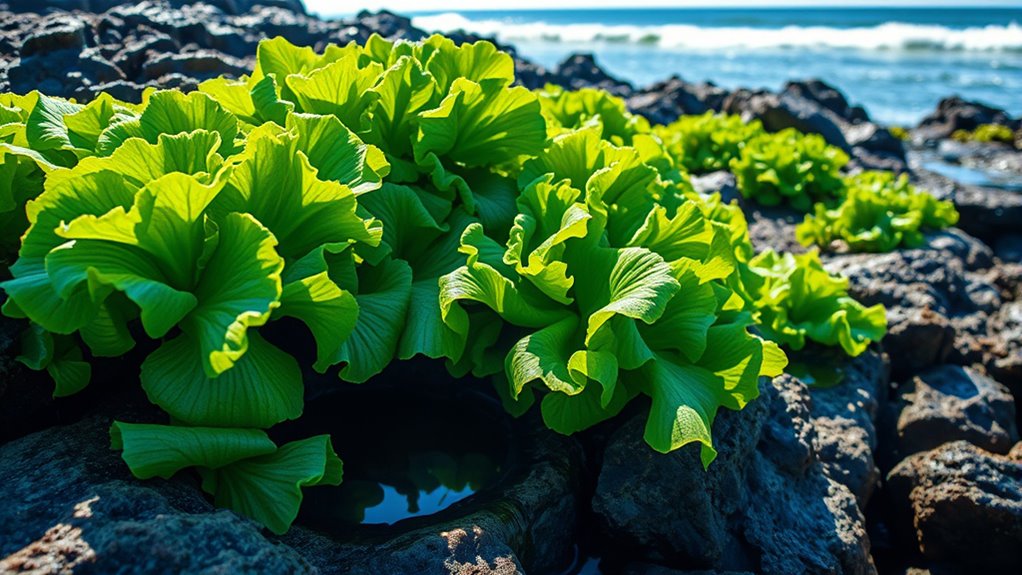
You can easily identify sea lettuce by its bright green, thin, leafy appearance, and it’s commonly harvested from rocky coastlines. Its high nutritional value makes it a popular addition to many dishes, providing vitamins and minerals. When preparing sea lettuce, consider simple ways to incorporate it into salads or soups for a fresh, oceanic flavor.
Identification and Harvesting
Have you ever wondered how to identify and harvest Sea Lettuce (Ulva lactuca)? To do so responsibly, focus on sustainable harvesting practices that protect seaweed ecology. Start by recognizing these key features:
- Look for thin, bright green, leafy sheets that form a loose, ruffled mat.
- Check for smooth, lobed edges without a central stalk.
- Confirm it’s growing attached to rocks or other stable surfaces in intertidal zones.
- Harvest when the seaweed is lush, vibrant, and free of dark spots or slimy patches.
- Additionally, understanding the importance of seaweed ecology helps ensure responsible harvesting and conservation.
Always harvest responsibly, leaving enough to maintain healthy populations. Proper identification and mindful harvesting assure you enjoy seaweed’s benefits while preserving its ecological role.
Nutritional Benefits Overview
Sea Lettuce (Ulva lactuca) isn’t just easy to identify and harvest—it also boasts impressive nutritional qualities. Rich in vitamins A, C, and E, it supports your immune system and skin health. It’s a great source of essential minerals like calcium, magnesium, and iodine, which are crucial for proper thyroid function and maintaining electrolyte balance. Sea Lettuce’s high antioxidant content helps combat free radicals, promoting overall well-being. Its presence in coastal ecosystems contributes to marine biodiversity by providing habitat and food for various marine species. Additionally, practicing responsible harvesting ensures the sustainability of coastal environments while enjoying its benefits. By harvesting Sea Lettuce responsibly, you’re supporting healthy coastal ecosystems while benefiting from its dense nutritional profile. Incorporating Sea Lettuce into your diet can enhance your health while appreciating its role in sustaining vibrant marine environments.
Culinary Preparation Tips
To incorporate Sea Lettuce (Ulva lactuca) into your dishes, it’s best to start by rinsing it thoroughly under cold water to remove any sand or impurities. Once cleaned, follow these tips for ideal preparation:
- Blanch briefly in boiling water to mellow its flavor and enhance texture.
- Add to salads raw for a fresh, crisp taste that highlights its natural flavor.
- Sauté lightly with garlic and olive oil to boost flavor and preserve its vibrant green color.
- Use in soups or broths as a sustainable harvesting option to maximize flavor enhancement without overharvesting. These methods help you enjoy Sea Lettuce’s delicate taste while supporting sustainable harvesting practices. Proper preparation ensures you get the most flavor and nutritional benefits from this versatile seaweed. Additionally, understanding the quorum sensing mechanisms of marine microorganisms can provide insights into sustainable harvesting methods and ecosystem health.
Irish Moss (Chondrus Crispus)
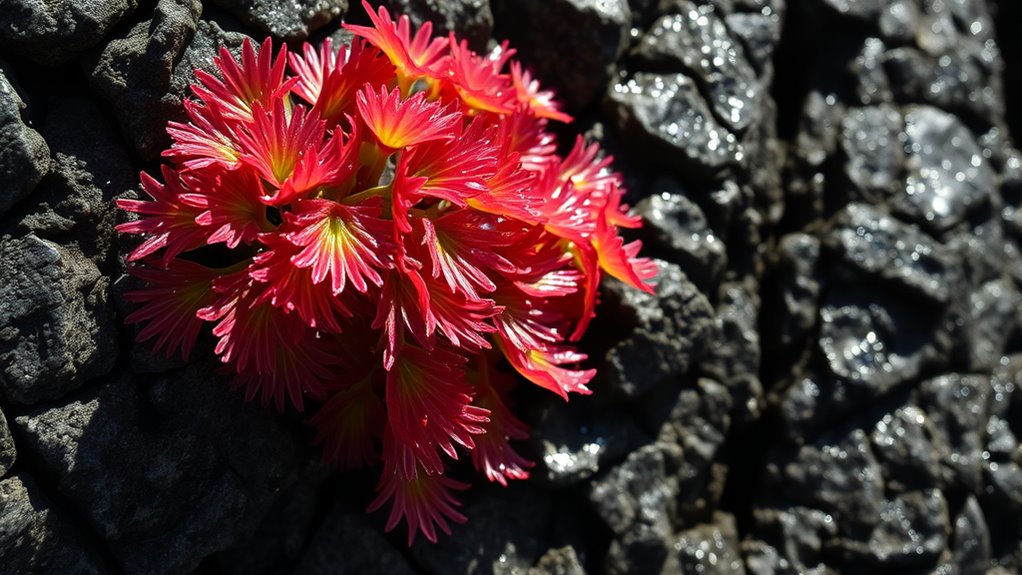
Irish moss, also known as Chondrus crispus, is a vibrant red seaweed that grows along the rocky Atlantic coasts of Europe and North America. When harvesting, you should gently clip the healthy, bushy fronds with scissors or knives, avoiding damaged or dead sections. It’s best to harvest during low tide when the seaweed is accessible without disturbing the ecosystem. To preserve your bounty, rinse the moss thoroughly with seawater or fresh water to remove sand and debris. Then, you can air-dry it in a shady, well-ventilated area or use low heat to dehydrate it. Proper preservation methods guarantee the seaweed retains its nutrients and flavor, making it ready for culinary use later. Always harvest sustainably to protect the natural populations. Additionally, ensuring proper drying techniques helps maintain the nutritional value of the seaweed for future use.
Alaria (Alaria Esculenta)
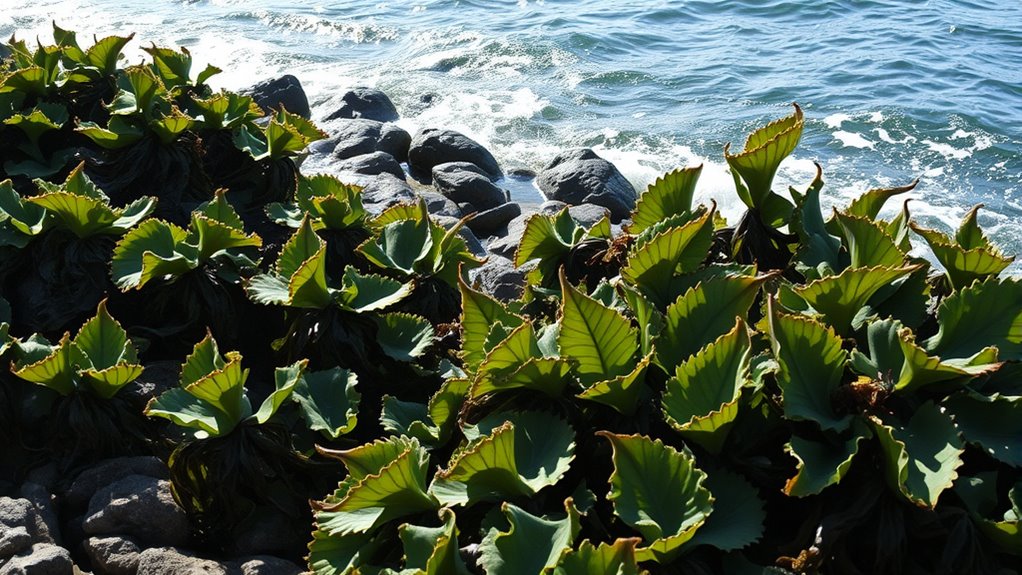
Alaria, also known as Alaria Esculenta, is a large, brownish-green seaweed that thrives along the North Atlantic coasts. You can harvest this versatile seaweed for culinary use and support sustainable practices like seaweed farming, which benefits marine conservation. Here are four reasons to explore Alaria:
Discover Alaria Esculenta: a nutritious, sustainable seaweed supporting marine conservation and local food sources.
- Rich in vitamins and minerals, boosting your health.
- Easy to harvest on the coast, promoting local food sources.
- Its sustainable growth helps reduce environmental impact.
- Supports marine conservation efforts by encouraging responsible harvesting.
Additionally, understanding the role of AI in cybersecurity and other sectors can help ensure the safe development and use of seaweed harvesting technologies.
Hijiki (Sargassum Fusiforme)
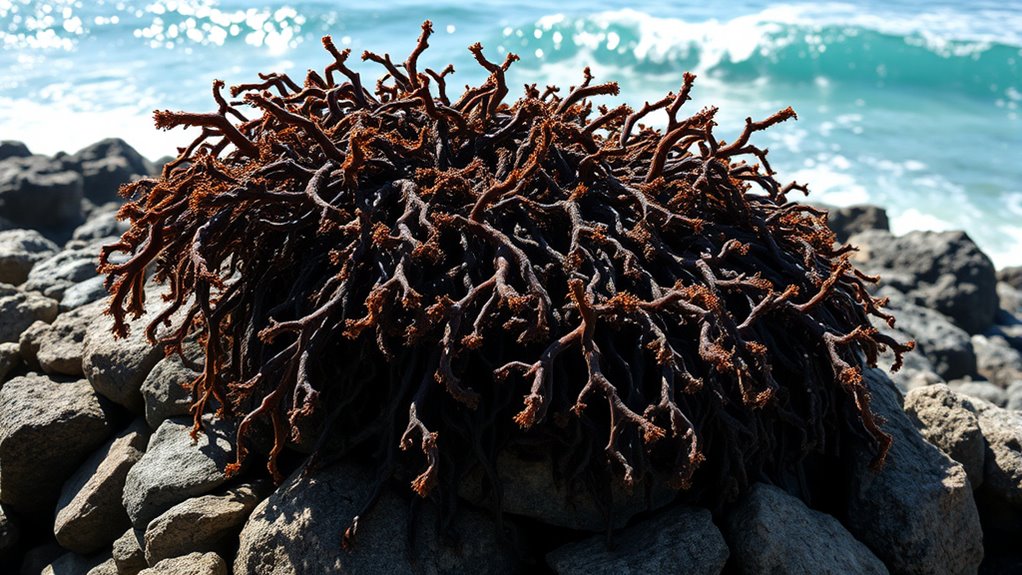
Hijiki (Sargassum fusiforme) is a dark, brittle seaweed popular in Asian cuisines for its rich flavor and nutritional benefits. When harvesting hijiki, use careful techniques like hand-picking or cut-and-collect methods to minimize damage to the surrounding environment. Sustainable harvesting involves leaving portions of the seaweed intact so it can regenerate naturally. Be aware of environmental impacts, as overharvesting can disrupt local ecosystems and marine life. Avoid using heavy equipment that can disturb the seabed or harm other marine organisms. Proper timing and moderation are key to maintaining healthy populations. By practicing responsible harvesting techniques, you help ensure hijiki remains a sustainable and nutritious resource for future generations while protecting coastal ecosystems. Additionally, harvesting techniques should prioritize minimal disturbance to promote the long-term health of the seaweed beds.
Agar-Agar (Gelidium Spp. and Gracilaria Spp.)
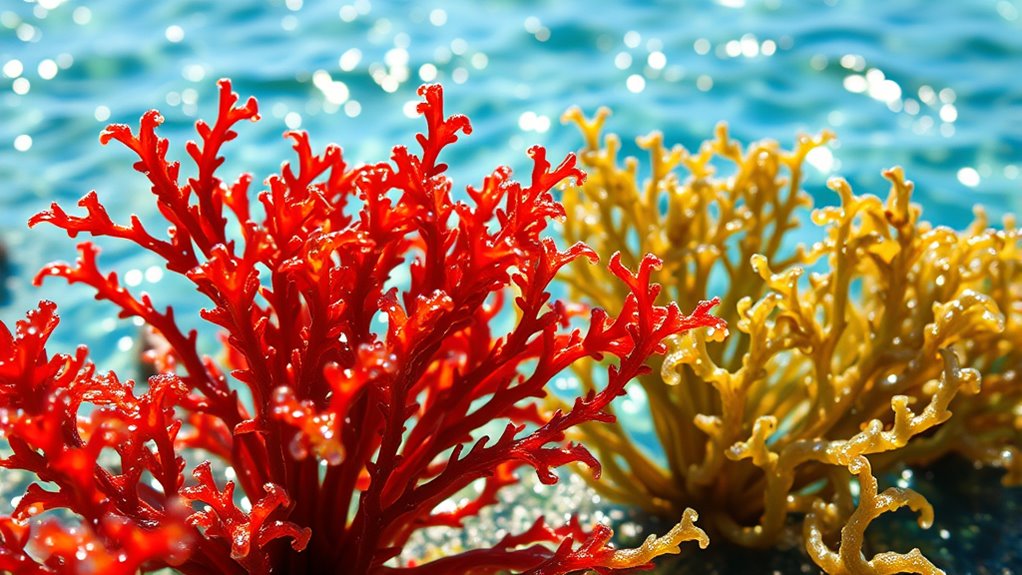
Agar-agar, derived from Gelidium and Gracilaria species, is a versatile, plant-based gelatin substitute widely used in cooking and food processing. When harvesting agar-agar, you can:
- Support seaweed farming practices that promote sustainable harvesting.
- Discover how local communities harvest Gelidium and Gracilaria responsibly.
- Learn simple methods to extract agar-agar at home or on the coast.
- Explore delicious recipes using agar-agar as a vegan gelatin alternative.
Frequently Asked Questions
Are Edible Seaweeds Safe for People With Shellfish Allergies?
If you have shellfish allergies, you should be cautious with edible seaweeds because of potential cross reactivity concerns. While seaweeds aren’t shellfish, some individuals might experience allergic reactions due to shared proteins. It’s best to consult allergy testing guidelines and speak with your healthcare provider before trying seaweeds. They can help determine if you’re at risk and advise on safe consumption to avoid adverse reactions.
What Is the Best Time of Year to Harvest Each Seaweed?
You should consider seasonal growth and harvesting timing to get the best quality. Typically, spring and early summer are ideal for harvesting many seaweeds, as they experience peak growth. For example, kelp is best collected in late spring or early summer, while nori is harvested in late summer. Timing your harvest during these peak periods guarantees fresh, nutritious seaweeds and helps sustain their seasonal growth cycles.
How Do I Identify Edible Seaweed Species in the Wild?
Did you know there are over 10,000 seaweed species worldwide? For successful seaweed identification, focus on key features like color, texture, and shape. Use wild harvesting techniques such as checking for firm, unbroken fronds and avoiding slimy or slimy-looking plants. Always verify with local guides or reputable field guides to guarantee you’re harvesting edible species safely. Proper identification helps prevent toxic lookalikes and promotes sustainable harvesting.
Can I Harvest Seaweeds Sustainably Without Damaging the Environment?
You can harvest seaweeds sustainably by following best practices that minimize environmental impact. Focus on selective harvesting, taking only what’s needed and leaving enough to ensure regrowth. Avoid damaging the delicate holdfasts and avoid overharvesting in one area. By respecting local guidelines and monitoring your impact, you help maintain healthy ecosystems while enjoying your harvest. Sustainable harvesting supports both the environment and your ongoing access to these valuable coastal resources.
Are There Any Health Risks Associated With Consuming Wild-Harvested Seaweeds?
Did you know that up to 75% of wild-harvested seaweeds can contain contaminants? You should be aware of seaweed toxicity and contamination concerns before eating wild seaweeds, as pollutants like heavy metals or bacteria can pose health risks. Always source from clean, reputable areas, and consider testing or cooking thoroughly to reduce potential dangers. Staying informed helps you enjoy the benefits without risking your health.
Conclusion
So, next time you’re tempted to buy fancy snacks, remember the coast has something even better—edible seaweeds. They’re packed with nutrients and surprisingly easy to harvest. Ironically, the ocean’s bounty requires minimal effort, yet we often overlook it. So, go ahead, plunge into—literally—and enjoy these salty treats that nature’s been offering for centuries. Who knew that the best snacks might just be lurking beneath the waves?

